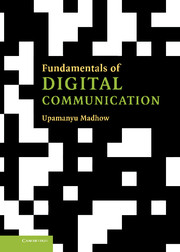Book contents
- Frontmatter
- Contents
- Preface
- Acknowledgements
- 1 Introduction
- 2 Modulation
- 3 Demodulation
- 4 Synchronization and noncoherent communication
- 5 Channel equalization
- 6 Information-theoretic limits and their computation
- 7 Channel coding
- 8 Wireless communication
- Appendix A Probability, random variables, and random processes
- Appendix B The Chernoff bound
- Appendix C Jensen's inequality
- References
- Index
1 - Introduction
Published online by Cambridge University Press: 05 June 2012
- Frontmatter
- Contents
- Preface
- Acknowledgements
- 1 Introduction
- 2 Modulation
- 3 Demodulation
- 4 Synchronization and noncoherent communication
- 5 Channel equalization
- 6 Information-theoretic limits and their computation
- 7 Channel coding
- 8 Wireless communication
- Appendix A Probability, random variables, and random processes
- Appendix B The Chernoff bound
- Appendix C Jensen's inequality
- References
- Index
Summary
We define communication as information transfer between different points in space or time, where the term information is loosely employed to cover standard formats that we are all familiar with, such as voice, audio, video, data files, web pages, etc. Examples of communication between two points in space include a telephone conversation, accessing an Internet website from our home or office computer, or tuning in to a TV or radio station. Examples of communication between two points in time include accessing a storage device, such as a record, CD, DVD, or hard drive. In the preceding examples, the information transferred is directly available for human consumption. However, there are many other communication systems, which we do not directly experience, but which form a crucial part of the infrastructure that we rely upon in our daily lives. Examples include high-speed packet transfer between routers on the Internet, inter- and intra-chip communication in integrated circuits, the connections between computers and computer peripherals (such as keyboards and printers), and control signals in communication networks.
In digital communication, the information being transferred is represented in digital form, most commonly as binary digits, or bits. This is in contrast to analog information, which takes on a continuum of values. Most communication systems used for transferring information today are either digital, or are being converted from analog to digital.
- Type
- Chapter
- Information
- Fundamentals of Digital Communication , pp. 1 - 6Publisher: Cambridge University PressPrint publication year: 2008



